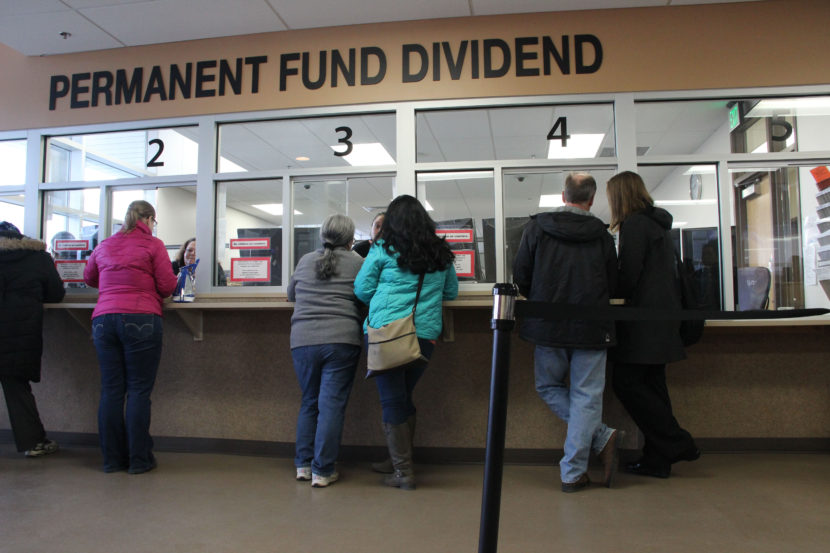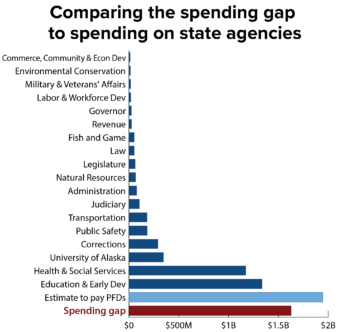
Gov. Mike Dunleavy has said Alaskans should receive permanent fund dividends of roughly $3,000 this year. The proposal follows up on a campaign pledge that helped him get elected governor in November. But it won’t be easy for lawmakers to agree on the dividend’s size this year.
Every dollar the state pays out in permanent fund dividends is a dollar that won’t pay for government services. It’s pretty simple math, but recently the Legislature’s nonpartisan budget expert David Teal made it clear finding a solution won’t be easy.
“To sum up, the competition between dividends and government services creates a huge fiscal problem for you legislators,” Teal said.
Alaskans elected Gov. Dunleavy and many legislators based in part on a desire to base dividends on a generous formula set in a 1982 law that was used until three years ago. But when combined with current oil prices, the so-called “full” PFDs would lead to a projected gap of $1.6 billion between what the state spends and what it brings in.
To close the gap would cost more than the state spends on public education each year. It’s also more than the state spends combined on 12 of the 14 departments of state government, including transportation and public safety.
Sitka Republican Sen. Bert Stedman is getting ready for an intense debate over cutting the budget to pay full PFDs this year.
“Well, you’re looking at a 30-percent reduction in one year,” Stedman said of budget cuts. “That’s going to be a jaw dropper, and I’m going to need a bottle of Rolaids to get through the budget process.”

Stedman thinks that, ultimately, lawmakers will figure out a way to deliver full PFDs — at least for this year. And he expects voters to push back against any proposal to cut it.
“It’ll be a hotly debated issue, especially if we don’t pay out the statutorily derived dividend,” he said. “Frankly, I think the public will throw more elected officials out on the street. And I think if you go back and look at the last election, there’s a few of them that got their butts bounced out over it.”
About three-quarters of the permanent fund is protected from the Legislature spending it. But that still leaves about $16 billion in fund earnings that the Legislature could spend.
Stedman said the Legislature should take steps to protect the earnings in the long term. He’d like to amend the state constitution to protect the earnings in the same way that the main portion of the permanent fund is protected.
This isn’t likely to happen this year, since constitutional amendments are only voted on in general election years like next year. But Stedman said the Senate Finance Committee will be talking about the permanent fund this year, “because all roads lead to the permanent fund to balance the budget.”
Ketchikan independent Rep. Dan Ortiz could serve on the House Finance Committee once a House majority coalition has formed. He said he wants a full PFD, but only if it makes financial sense.
Ortiz described how he’ll approach the budget: “I’ll take a look at that, see what cuts are being called for in order to pay out that full PFD,” he said. “And then I’m going to put together a survey and send it to all the registered voters in my district and say, ‘OK. Here’s the situation. If we are going to pay a full PFD this year, these are the cuts that we’re going to be looking at in order to pay for that. What do you guys think?’”
Ortiz said voters may have endorsed Dunleavy’s position on the PFD, but they did it without knowing how his promise to reduce the size of government would affect the services they receive, including basic services like public education and the ferry system.
“Gov. Dunleavy got the endorsement of a significant portion of the population of voters,” Ortiz said. “But what didn’t go along with that is the opportunity costs that were going to be associated with those full payouts.”
Those trade-offs will become more clear on Feb. 13, when Dunleavy releases an amended budget. North Pole Republican Rep. Tammie Wilson is concerned the Legislature will spend in a way that will threaten the permanent fund itself.
Wilson said the Legislature should focus on cutting government spending.
“We have to get our house in order, or else it’s not just about the dividend anymore,” she said. “We don’t even have the population to possibly tax people to be able to sustain the government that we currently have. And that I think doesn’t just scare individuals, but the businesses and the potential businesses that come here.”
The Senate Finance Committee is already holding hearings ahead of the release of the amended budget.
Correction: An earlier version of the graph in this story omitted the Department of Administration. The graph has been updated.